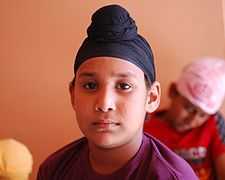Ushnisha
| Part of a series on |
| Buddhism |
|---|
 |
|
The ushnisha (Sanskrit, n., उष्णीष, IAST: uṣṇīṣa) is a three-dimensional oval at the top of the head of the Buddha. It symbolizes his attainment of reliance in the spiritual guide.[1]
The ushnisha was not described initially in the Physical characteristics of the Buddha spelled out by the Buddhist canon. Rather, there are several mentions about a topknot:
- "His topknot is like a crown." (Secondary characteristics, No53)
- "He has a topknot as if crowned with a flower garland." (Secondary characteristics, No80)
The first representations of the Buddha in the 1st century CE in the Greco-Buddhist art of Gandhara also represent him with a topknot, rather than just a cranial knob. It is thought that the interpretation of the ushnisha as a supernatural cranial protuberance happened at a later date, as the representation of the topknot became more symbolized and its original meaning was lost (Mario Bussagli, "L'art du Gandhara").
The Boddhisattva-Cakravartin in Early Buddhism

In Early Buddhism, the uṣṇīṣa was represented differently. The Mahāvastu (1.259f) and the Divyāvadāna, as well as the Theravadin Milindapañha, describe the marks of the cakravartin or "idealised world-ruler": uṣṇīṣa or patka turban, chhatra "parasol", "horn jewel" or vajra, whisk and sandals. These were the marks of the kshatriya.[2]
The plastic art of early Mahayana Buddhism in Mathura presents bodhisattvas in a form called uṣṇīṣin "wearing a turban/hair binding", wielding the mudras for "nonviolent cakravartin rule".[2]
See also
References
- ↑
- "The true Buddha head is bare, covered only with ringlets of hair (plate 560) and surmounted by a peculiar swelling, the "usnisa", which is one of the thirty two traditional "great marks" (Maha-Laksana) of the Buddhist superman-savior. Sometimes on the Usnia there is represented a small image of the transcendent Spiritual Buddha from whom the historical savior is an emanation: the supramundane source whence his phenomenal appearance proceeds. But never does the Buddha wear a kingly crown" page 67 (The Art of Indian Asia vol 1. Zimmerman). "The Bodhisattva, it will be remembered, departed from his palace, cross the border-river of his father's Kingdom, and on it's bank severed, with a single stroke of his sword, the tuft of his hair, saying "If it is destined to me to become a Buddha, may my hair and head-cloth remain hanging in the air; if not, let them fall to the ground". A God caught both, transported them to the heaven of the Trayastrimsat Gods, and there a Chaitya-Cudamani was constructed". page 233.
- ↑ 2.0 2.1 Falk, Harry, "Small-Scale Buddhism" in Voegeli, François; Eltschinger, Vincent; Candotti, Maria Piera; Diaconescu, Bogdan; Kulkarni, Malhar, eds. (2012). Devadattīyam : Johannes Bronkhorst felicitation volume. Bern: Peter Lang. ISBN 9783034306829., p. 495